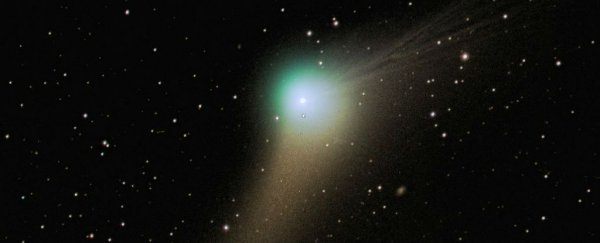Over the next few weeks, one of the most beautiful comets we've ever discovered, Comet Catalina, will pass by Earth in what's expected to be its first and only visit to the inner Solar System.
And while its closest flyby for those in the Northern Hemisphere will be on 17 January 2016, you might want to stash some binoculars in your bag on New Year's Day - on 1 January, Comet Catalina is expected to move within 0.4 degrees (less than the apparent width of the Moon) of Arcturus - one of the brightest stars in the sky. If ever there were a ridiculous space photography moment, this is it.
Whenever you choose to look up, just make sure you've got some help. Comet Catalina should be pretty bright, and against really dark skies you might be able to spot it with the naked eye, but it's best to be prepared and take some binoculars or a little telescope with you on your skywatching trip.
The best time to spot it will be late at night on 17 January, when it'll be about 100,000,000 kilometres away. That sounds like a whole lot, but that's actually pretty close for a comet. Once it hits its closest point, it'll draw away from Earth, becoming increasingly hard to see, so make that your deadline!
Oh and bad news for our Southern Hemisphere readers - if you haven't seen Comet Catalina this year already, it's too late now. Better hop on a plane quick-smart!
The Sky and Telescope website has a map of the sky that'll help those of you in the Northern Hemisphere find it.
Comet C/2013 US10 Catalina imaged on Dec. 9, 2015 https://t.co/XcKjNcXXuZ image credit: @sen / @peachastro pic.twitter.com/0sTgWMobDx
— sen (@sen) December 16, 2015
As astronomer Phil Plait says over at Slate, what makes this comet so special is that because of a trick of perspective, Comet Catalina looks like it's got two tails pointing in different directions.
One's made from gas and the other from dust, and because of the angle from which those in the Northern Hemisphere will be viewing it, it looks like tail is shooting out in front of it and one behind. Have your cameras ready!
The other really cool thing is where Catalina has been for the past several million years. Plait explains:
"Catalina is coming from very deep space, probably out in the Oort cloud - the vast repository of icy bodies far, far beyond the orbit of Neptune. Its orbit may have originally been millions of years long!
But something gave it a kick - perhaps a star that passed a couple of light years away a million years ago, or the tides from the galaxy itself - and dropped it toward the Sun. This kick also gave it a teeny bit more energy, just enough added speed that it achieved escape velocity. That means it has enough energy to escape from the Sun altogether, and is on its way out of the Solar System forever (this is technically called a hyperbolic orbit)."
So don't let this one go - you've got one shot this month, and then it's gone forever. Get your cameras, binoculars, and telescopes ready, and if New Year's Day is becoming all too stressful because you don't know what to do when with whom, just tell everyone you're spending it with Comet Catalina.
